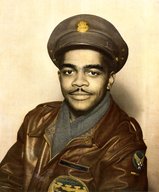
|

|
|
|
|
Thomas was born in Warrenton, North Carolina as one of nine children of Jessie Robert Richardson and Lucy Alston Richardson. The siblings included Elizabeth, George, Jessie, Thomas, Martha, Roger, and Selma. The senior Richardson was "a log man". He held other jobs during the Great Depression, including hotel bellhop and boiler operator and also participated in the Works Progress Administration. Dr. Richardson describes his boyhood home as a "mixed community as far as races were concerned. The first family south of us was white. The next one was black and the rest of them were white," he remarks, adding that most distances between residences were "something like half a football field." The family raised a garden for fresh vegetables that his mother canned, and kept a pig and a cow for meat and milk. They also bought vegetables on Saturday from a man with an ox cart. Teachers, he says, were paid script that many stores accepted but did not give patrons full value. Working through the Parents-Teachers' Association, families gave teachers places to stay. "I remember we would have a teacher stay with us a month, and she would move on somewhere else and another teacher would come in and stay with us. "The teachers got to know the parents. We fed them and gave them a place to stay. And some good things came out of it," he says. Thomas enjoyed both academics and athletics. He played football and basketball. He also worked--hard. He pedaled a paper route, including three "major black newspapers: The Pittsburgh Courier, The Chicago Defender and The Norfolk Journal and Guide. In summers after last three years of high school he worked at hotels and saved enough money to pay his tuition for his first year at Hampton Institute, now Hampton University in Hampton, Virginia. Dr. Richardson finished high school in 1943 and entered Hampton Institute. He loved college life, but soon was drafted. At age 18 he was sent to Camp Lee in Virginia, where he was placed in the 477th Bombardment Group, an all-black unit. From Camp Lee he was sent to Keesler Field near Biloxi, Mississippi for basic training. The town, he remarks, was not a good place for black men. "A lot of the older men...would tell us about things like after five o'clock blacks couldn't be seen in white neighborhoods because all the cooks and maids who didn't live there had left. So black soldiers were arrested for almost anything. Only MPs were supposed to arrest soldiers, but city policemen often threw black soldiers in jail. Meanwhile, pressure from higher places was intended to begin allowing black soldiers into more meaningful positions other than what he calls "the dirty jobs". Dr. Richardson was sent to armory school at Lowery Field in Denver, Colorado, then to Gardner Field adjacent to Fort Knox in Kentucky, where the 477th Bombardment Group (its men now considered as Tuskegee Airmen) was formed. Racial tensions continued. "White soldiers refused to salute black officers and nothing was done about it. So the colonel who was over our outfit we found out hated the job so blacks got treated pretty rough," he remarks. Relations were no better at a field in Indiana where he went next. White soldiers boarded buses going to Indianapolis first; if there were no room left, black soldiers had to wait for the next bus. At gunnery school in Fort Myers, Florida, he learned gunnery skills on B-25s as a tail gunner. By then the war in Europe had ended. He was sent to a staging area in South Carolina, believing the Pacific Theater was his next stop. There he learned skip bombing used in low-altitude flights. He claims the 477th never had a plane to crash, nor did it lose any crewmembers. Prominent African-American newspapers at the time questioned why the stellar unit was not allowed to go overseas. Japan surrendered when he was in South Carolina. Recruiting officers urged him to stay in the military but he yearned for college life. "When the war was over with that's all I could think about, was getting back into college. In 1950 he completed an education degree with an emphasis in art, and began teaching at Claflin University in Orangeburg, South Carolina. To obtain a master's degree he was accepted at Texas College, in Tyler, Texas, where he met his wife, Thelma Powell. They married on January 16, 1954. Soon Dr. Richardson was hired as the art teacher at Grambling University. Thelma became a secretary to the librarian, but after one year earned the title of librarian. Dr. Richardson earned his PhD at Pennsylvania State University. Eventually, he would teach for more than 50 years at Grambling. |


